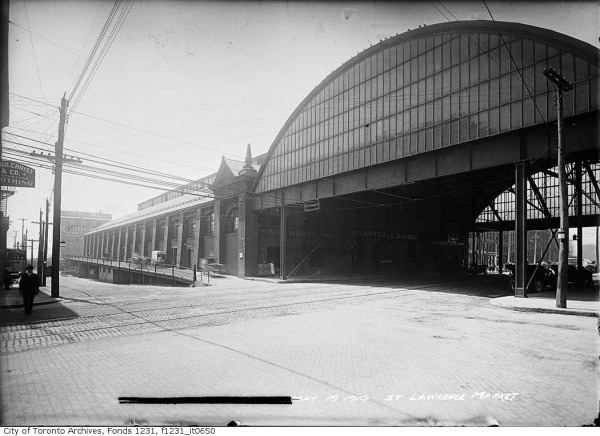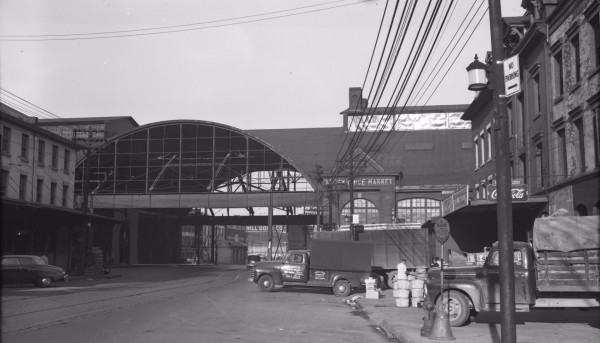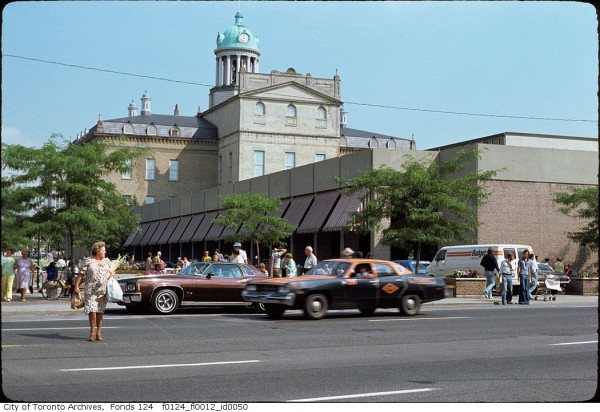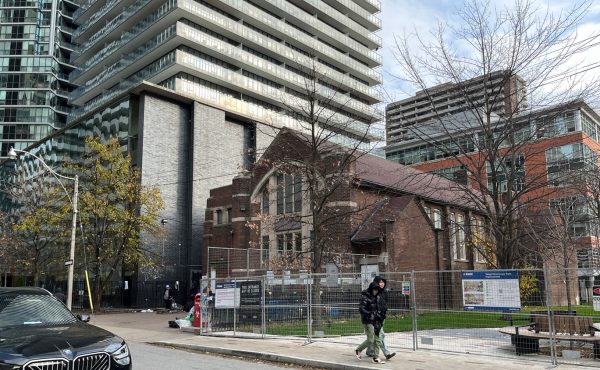In 2012, National Geographic ranked the St. Lawrence Market the best in the world. The vendors on both sides of Front Street were lauded for the quality of their produce and the beauty of their surroundings. The city even got a nod in the write-up for the regeneration of the St. Lawrence neighbourhood in the 1960s, 70s and 80s.
Unfortunately, the successful revitalization effort cost the market one of its best features, a massive steel and glass canopy that once loomed over Front Street and linked the south market to a building that was its architectural twin. If the canopy still existed, today’s shoppers who scramble across Front street would be covered by its shade.
First, a little back story on the various buildings of the St. Lawrence Market.
The city block south of King, west of Jarvis, has been a place of commerce for more than 200 years. The land was set aside for trading in 1803 during the first planned expansion of the Town of York. Space was also allocated for a church, hospital, school, court house, and jail.
The first market building, which was located on King Street where St. Lawrence Hall stands today, was a two-storey structure with an open central square. Broad archways allowed horse-drawn wagons to pass in and out. It was damaged during the city’s first great fire and replaced in 1850 with a Georgian-style building on the south side of Front, which also doubled as York’s first purpose-built city hall. (The first city hall, technically a “town hall,” was in the first market building at King and Jarvis..)
The new three-storey red and white brick civic headquarters with its neat little clock tower and pair of two-storey wings housed a police station complete with basement jail cells, the council chamber, and the offices of the mayor and city aldermen. Out back, vegetable, poultry, and fish stalls backed directly on to the waterfront.
Directly opposite the city hall, where the first market had once stood and the squat north market is to be found today, was the first commercial property to carry the “St. Lawrence” name. It was attached to the back of St. Lawrence Hall and was reserved for meat sellers. Noisy animal stalls lined its corridors.
The combined city hall and south market, at this time still physically separate from its northern counterpart, was extensively remodelled in 1902, a few years after the city moved its headquarters north to “Old” City Hall at Queen and Bay. The central part of the structure that housed the council chamber was absorbed into what is now the south market, and the existing retail floor with its arched roof added to the rear.
Two years later, a matching covered market was constructed on the north side of Front Street and the pair linked by a massive canopy that spanned the width of the street. The streetcar stopped under it, its riders shielded from the rain and snow, and pigeons roosted in its upper tiers. Walls of glass on either side allowed natural light to fill the space underneath.
The 1904 north market was built to exactly match the south building. It had the same glazed brick exterior, iron girder roof, and neat decorative features, such as embossed stone lettering on each corner. Like today, the north building housed the St. Lawrence farmer’s market and permanent stalls were located over the street.
Historian John Ross Robertson wasn’t a fan of the matching $200,000 north market, however. Writing in his 1908 book Landmarks of Toronto, the former newspaper editor complained that the structure was “far more businesslike than its predecessor and by no means the same attractiveness.”
“The glories of the old St. Lawrence Market are but a memory,” he wrote. “There is positively no comparison between the St. Lawrence Market as it present exists and its predecessor of even 10 years since.”
Robertson did, however, provide plenty of useful detail about the hall where farmers, hucksters, and butchers sold produce from the backs of sleighs and wagons. The roof, he said, was exactly 82 feet and 6 inches from the ground. The main floor was 144 feet wide, 349 feet long with numerous open entrances wide enough for horse-drawn vehicles to enter from the street.
In later years, bleachers were added to the outer walls for the National Horse Show, along with several other minor interior alterations.
The demise of the north market began in 1954 with the removal of the Front Street canopy. Wreckers knocked out the glass windows and severed its massive iron supports before taking the whole thing down, piece by piece.
The north building lingered another 13 years, until 1967, when it was replaced with the current squat concrete box. Colourful hoarding was wrapped around the historic exterior as it was slowly dismantled to make way a heated hall capable of hosting “teen dances, auctions, bingos, and antique shows” in addition to a market.
The Toronto Star promised the new $500,000 structure would be “well-lit, supermarket-shiny building.” It even came with an ornamental waterfall and twelve carved heads representing each of the apostles on the exterior.
The demolition of the canopy and the north market was met with little public resistance, it appears. At the time, both of the north and south markets were in dire need of renovation, and city wanted to start from scratch.
A concerted effort by Professor Eric Arthur, the chairman of the St. Lawrence Advisory Committee and author of the seminal book of nineteenth century architecture Toronto: No Mean City, failed to persuade council to rebuild the market in a style close to the original.
In 1968, city property commissioner Harry Rogers, whose plan had won out over Arthur’s, expected the south market to be razed in the next few years, too. His plan envisioned a replacement being built south of the Esplanade and the old site becoming a pedestrian mall or parking lot.
Happily, the home of the world’s best market was saved from the fate of its twin.
With any luck, the next incarnation of the north market will be finished in 2016.
Some modifications have been made to this article since it was originally published.
Images: City of Toronto Archives and Toronto Public Library, S 1-1211.






